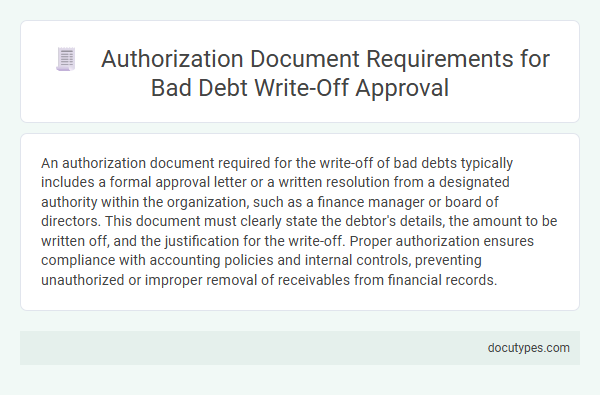An authorization document required for the write-off of bad debts typically includes a formal approval letter or a written resolution from a designated authority within the organization, such as a finance manager or board of directors. This document must clearly state the debtor's details, the amount to be written off, and the justification for the write-off. Proper authorization ensures compliance with accounting policies and internal controls, preventing unauthorized or improper removal of receivables from financial records.
Introduction to Bad Debt Write-Off Authorization
Authorization documents are crucial for the write-off of bad debts to ensure proper financial control and compliance. These documents provide official approval that a debt is uncollectible and can be removed from the accounts.
- Bad Debt Write-Off Authorization Form - This form serves as the official record that approves the removal of specific bad debts from financial statements.
- Managerial Approval - A signed approval from a manager or authorized personnel is necessary to validate the legitimacy of the write-off request.
- Supporting Documentation - Collection efforts, correspondence, and evidence of uncollectibility support the decision and accompany the authorization form.
Importance of Authorization Documents in Bad Debt Management
Authorization documents are crucial for the write-off of bad debts as they provide formal approval and ensure accountability within financial management processes. Proper documentation helps prevent misuse and supports compliance with accounting standards and regulations.
- Approval Letter or Memorandum - Official written consent from authorized personnel authorizing the write-off of specific bad debts.
- Board or Management Resolution - Formal decision recorded in meeting minutes confirming the approval of debt write-offs by the company's governing body.
- Supporting Financial Documentation - Detailed records such as aged receivables reports and debtor correspondence validating the status of uncollectible debts.
Maintaining thorough authorization documents strengthens internal control and enhances transparency in bad debt management.
Key Elements Required in Authorization Documents
Authorization documents for the write-off of bad debts must clearly identify the debtor and specify the amount to be written off. These documents serve as official approval ensuring that the write-off complies with company policies and accounting standards.
Key elements required in authorization documents include the signature of authorized personnel and the date of approval. The document should also include justification for the write-off, supported by relevant financial records and management consent.
Regulatory Compliance for Bad Debt Write-Offs
What authorization document is necessary for the write-off of bad debts? Regulatory compliance requires a formal approval document, often a board resolution or an official authorization letter, to validate the write-off process. Your organization must retain this document to ensure audit trails and meet legal standards.
Approving Authorities and Signature Requirements
| Authorization Document | Bad Debt Write-off Approval Form or Official Write-off Request Document |
|---|---|
| Approving Authorities |
|
| Signature Requirements |
|
| Purpose of Authorization | To ensure proper accountability and control over the financial impact of bad debt write-offs |
| Document Retention | Authorized write-off documents must be retained for audit and compliance verification |
Supporting Documents for Write-Off Approval
Authorization for the write-off of bad debts requires specific supporting documents to ensure proper approval. These documents validate the legitimacy of the bad debt and justify its removal from the accounts.
Your approval request must include detailed records such as the original credit agreement, correspondence with the debtor, and evidence of collection efforts. Financial statements showing the outstanding debt and internal approval forms are also essential for compliance.
Documentation Process Flow for Bad Debt Authorization
The authorization document necessary for the write-off of bad debts is typically an official approval form or memo signed by an authorized finance or accounting manager. The documentation process flow for bad debt authorization begins with identifying uncollectible accounts, followed by submitting a detailed bad debt report to the finance department. You must ensure that the approval document is recorded and retained to maintain compliance and support audit trails.
Record Retention and Audit Trail Requirements
Authorization documents for the write-off of bad debts must comply with strict record retention and audit trail requirements to ensure accountability and transparency. Proper documentation supports financial accuracy and satisfies regulatory audits.
- Authorization Form - You need a formal written approval from a designated authority to process bad debt write-offs.
- Retention Period - Records related to bad debt write-offs must be retained for a minimum of 7 years to meet legal and auditing standards.
- Audit Trail - Comprehensive documentation must include dates, approvals, and justifications to create a clear audit trail for verification purposes.
Common Mistakes in Bad Debt Write-Off Documentation
The necessary authorization document for the write-off of bad debts typically includes a formal approval from senior management or the finance department. This document must clearly state the amount to be written off and the reason for the write-off.
Common mistakes in bad debt write-off documentation involve missing signatures, unclear approval levels, and inadequate explanation of the debt's irrecoverability. These errors can lead to audit issues and financial discrepancies. Ensuring your documentation is complete and properly authorized helps maintain accurate financial records and compliance with company policies.
What Authorization Document Is Necessary for Write-off of Bad Debts? Infographic

